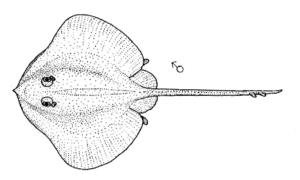Smooth deep-sea skate facts for kids
The smooth deep-sea skate (Brochiraja asperula) is a fascinating type of skate that lives deep in the ocean. It belongs to the family Arhynchobatidae, which includes many different kinds of skates and rays. This special fish is found only off the coast of New Zealand.
You can find the smooth deep-sea skate living on the continental shelf, which is the edge of a continent that is under the ocean. They prefer very deep waters, from about 200 meters (about 650 feet) down to 1,300 meters (over 4,200 feet)! These skates are not very big, usually growing to be about 30 to 50 centimeters (about 12 to 20 inches) long.
Quick facts for kids Smooth deep-sea skate |
|
|---|---|
 |
|
| Drawing by Dr Tony Ayling | |
| Scientific classification | |
| Synonyms | |
|
Contents
What is a Skate?
Skates are amazing fish that are closely related to sharks and rays. They have flat bodies and wide, wing-like fins that they use to glide through the water. Unlike sharks, skates do not have sharp teeth. Instead, they have flat plates in their mouths that help them crush their food.
Skates live on the ocean floor. They are often camouflaged, meaning their skin color and patterns help them blend in with the sand or rocks. This helps them hide from predators and sneak up on their prey.
Where the Smooth Deep-Sea Skate Lives
The smooth deep-sea skate is an endemic animal, which means it is found naturally only in one specific place. For this skate, that place is the waters around New Zealand. It lives in the deep, cold parts of the ocean.
The continental shelf is like a giant underwater ledge that extends from a continent. The smooth deep-sea skate lives on this shelf, where the water is still relatively shallow compared to the very deepest parts of the ocean. However, 200 to 1,300 meters is still very deep for most fish!
What the Smooth Deep-Sea Skate Eats
Like other skates, the smooth deep-sea skate is a carnivore, meaning it eats other animals. Because it lives on the ocean floor, it likely feeds on small creatures that also live there. This can include small fish, crustaceans like crabs and shrimp, and other invertebrates.
Skates often use their sense of smell and special sensors to find food buried in the sand or hiding among rocks. They are important predators in their deep-sea environment.
Life Cycle
Skates reproduce by laying eggs. Unlike many fish that release their eggs into the water, skates lay their eggs in tough, protective cases. These cases are often called "mermaid's purses" because of their unique shape.
The smooth deep-sea skate's eggs develop inside these cases on the ocean floor. The young skate hatches from the case when it is ready. It looks like a miniature version of the adult. We don't know all the details about the smooth deep-sea skate's full life cycle, but it's similar to other skates.
Conservation Status
The New Zealand Department of Conservation keeps track of how many animals and plants are in New Zealand and if they are in danger. They have classified the smooth deep-sea skate as "Data deficient" under the New Zealand Threat Classification System.
"Data deficient" means that scientists don't have enough information about this skate to know if its population is healthy or if it's in danger. It doesn't mean the skate is definitely in trouble, but it does mean we need to learn more about it. More research is needed to understand how many smooth deep-sea skates there are and what threats they might face.
See also
In Spanish: Brochiraja asperula para niños

